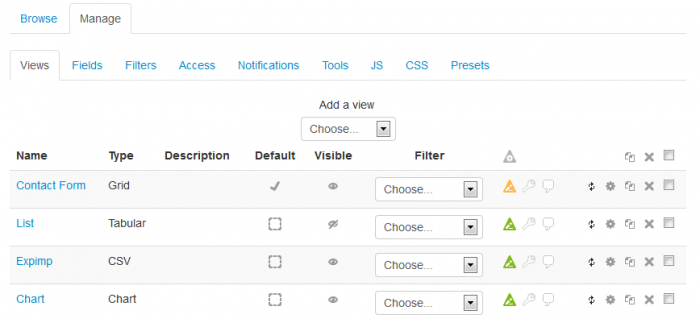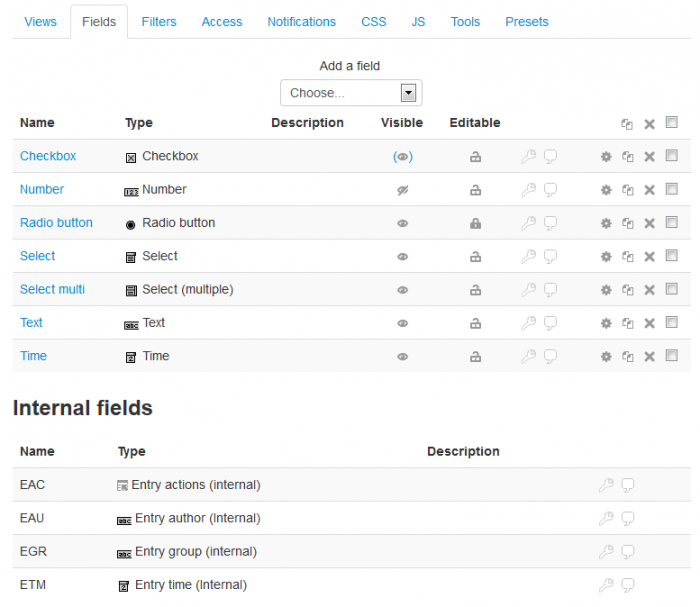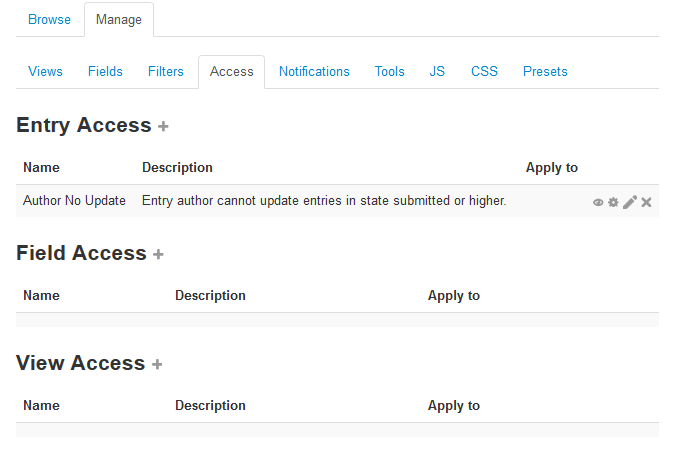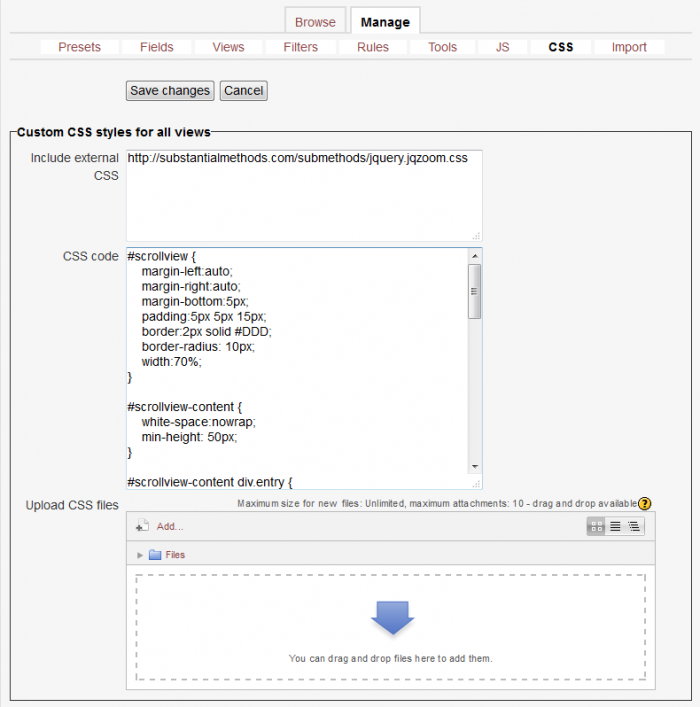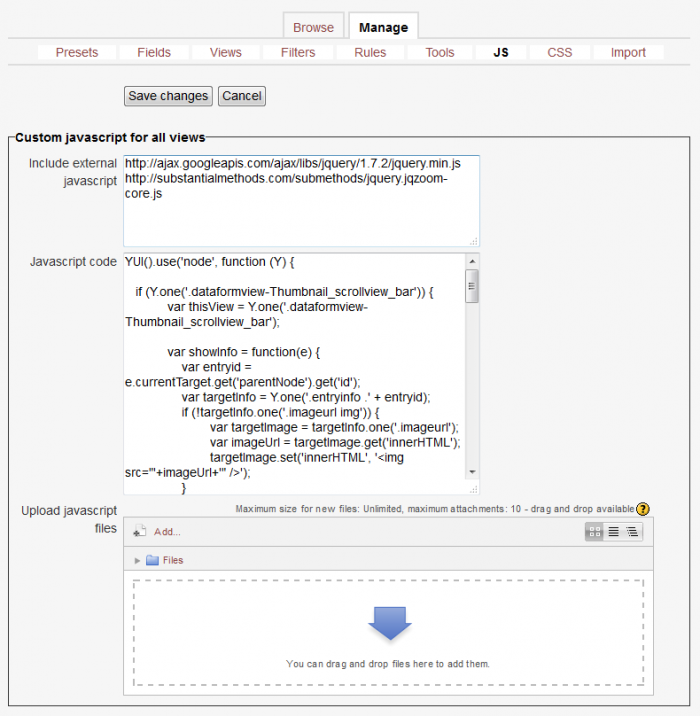Dataform building: Difference between revisions
- Overview
- Activity administration
- Building an activity
- CSS tips and tricks
- JS tips and tricks
- Activating RSS
- Activity workflow
- Grading
No edit summary |
No edit summary |
||
| Line 4: | Line 4: | ||
Dataform views allow you to control the way entries and other information is displayed in the activity. Views management is done under the Manage | Views tab and requires [[Capabilities/mod/dataform:managetemplates|Manage Dataform templates]] capability. | Dataform views allow you to control the way entries and other information is displayed in the activity. Views management is done under the Manage | Views tab and requires [[Capabilities/mod/dataform:managetemplates|Manage Dataform templates]] capability. | ||
[[File:df-views-index.png|700px]] | [[File:df-views-index.png|700px]] | ||
===Adding a view=== | ===Adding a view=== | ||
| Line 41: | Line 41: | ||
Dataform fields are used to enter, edit and store unit of information in an entry. | Dataform fields are used to enter, edit and store unit of information in an entry. | ||
[[File:df-fields-index.png|700px]] | [[File:df-fields-index.png|700px]] | ||
| Line 65: | Line 65: | ||
Dataform filters are used for sorting and filtering the activity entries in browse mode. | Dataform filters are used for sorting and filtering the activity entries in browse mode. | ||
[[File:df-filters-index.png|700px]] | [[File:df-filters-index.png|700px]] | ||
==Access rules== | ==Access rules== | ||
Dataform access rules can be used for controlling access to various areas/components of a Dataform activity. | Dataform access rules can be used for controlling access to various areas/components of a Dataform activity. | ||
[[File:df-access-rules-index.png|700px]] | [[File:df-access-rules-index.png|700px]] | ||
==Notification rules== | ==Notification rules== | ||
Dataform notification rules can used for defining and sending custom notifications to the activity participants. | Dataform notification rules can used for defining and sending custom notifications to the activity participants. | ||
[[File:df-notifiction-rules-index.png|700px]] | [[File:df-notifiction-rules-index.png|700px]] | ||
==CSS== | ==CSS== | ||
You can use CSS to manipulate the layout and styles of entries and content in any of the Dataform views. Any html element in the designated view, that has an id or a CSS class can be assigned specialized styles by including the style definitions in the CSS tab. | You can use CSS to manipulate the layout and styles of entries and content in any of the Dataform views. Any html element in the designated view, that has an id or a CSS class can be assigned specialized styles by including the style definitions in the CSS tab. | ||
[[File:df-css-tab.png|700px]] | [[File:df-css-tab.png|700px]] | ||
| Line 91: | Line 91: | ||
You can use javascript to manipulate the way entries are displayed and behave in any of the Dataform views. Any html element in the designated view, that has an id or a css class can be accessed and manipulated by javascript. | You can use javascript to manipulate the way entries are displayed and behave in any of the Dataform views. Any html element in the designated view, that has an id or a css class can be accessed and manipulated by javascript. | ||
[[File:df-js-tab.png|700px]] | [[File:df-js-tab.png|700px]] | ||
The Dataform allows you to add javascript in three ways: | The Dataform allows you to add javascript in three ways: | ||
| Line 101: | Line 101: | ||
TBC | TBC | ||
[[File:df-tools-index.png|700px]] | [[File:df-tools-index.png|700px]] | ||
==Setting permissions== | ==Setting permissions== | ||
TBC | TBC | ||
Revision as of 20:33, 27 February 2014
Views
Dataform views allow you to control the way entries and other information is displayed in the activity. Views management is done under the Manage | Views tab and requires Manage Dataform templates capability.
Adding a view
To add a view select the view type from the 'Add a view' dropdown. This will open the view configuration form where you can configure the view templates and behaviour. Typically, views have default configuration and if this default configuration serves your purpose you can simply enter a name for the view and save.
Setting the default view
The Dataform activity must have a default view to fall back on to when the activity is accessed without specifying the target view (for instance, when you access the activity from the activity link on the course page).
A Dataform activity without a default view is not ready and a message will be displayed on its front page and in the view list advising you to set a default view.
You can select the default view by clicking the 'Default' box in the view list. The selected default view is marked by a check sign. You can change the default view at any time. Since the default view must be visible, if you set a hidden view to default, this view will automatically become visible and you will not be able to hide it as long as it is the default view.
Setting view visibility
A view can be either visible or hidden. Visible views can be accessed by users with capability mod/dataform:viewaccess that is granted by default to all roles. Hidden views can be accessed by users with capability mod/dataform:viewaccesshidden that is granted by default only to the teacher role. Users without the required capability will not see views with the respective visibility setting in the standard views navigation menu (##viewsmenu##). Setting the view visibility can be done from the views index by clicking the eye icon of the designated view or from the visibility setting in the view configuration form. The default view must be visible and setting a hidden view as the default view will automatically change its visibility to visible.
Forcing a view filter
When filters are defined for the activity you can force a filter on a view by selecting the filter either from the index list or in the view configuration form. When the view forces a filter, users without capability mod/dataform:viewfilteroverride cannot apply other activity filters (the activity filters menu will not be displayed) and user advanced filters (if the option is added to the view) will be appended to the forced filter.
Resetting a view
Each view type has default templates which are generated and automatically added to the configuration form when adding a new view. The default View template typically consists of navigation menus, quick filters, add new entry link and entries display. The default Entry template (where applicable) typically adds the base pattern for each field and the edit and delete action buttons. As you build the activity you may change the templates of a view and in some cases you may wish to reset the templates to their defaults. This can be done by clicking the reset icon of the designated view in the views index or in the view configuration form.
Updating a view
You can click on the edit icon of the view to open the configuration form for updating.
Note: Clicking on the view name will open the view in browse mode rather than the configuration form.
Duplicating one or more views
You can duplicate a view by clicking the duplicate icon of the view. This will create an exact copy of the duplicated view with a different name. You can then proceed to update the view settings. This may be particularly useful if you need to create several very similar views. For example, you can create a complex view and then duplicate it, and assign to each of the instances a different filter so as to have a designated view for certain subsets of the entries.
You can duplicate more than one view in one go by selecting the designated views and clicking the bulk-duplicate icon (in the list's header).
Deleting one or more views
You can delete a view by clicking the delete icon of the view.
You can delete more than one view in one go by selecting the designated views and clicking and bulk-delete icon (in the list's header).
Access and Notifications info
Patterns validation and replacement
Fields
Dataform fields are used to enter, edit and store unit of information in an entry.
Adding a field
To add a field select the field type from the 'Add a field' dropdown. This will open the field configuration form where you can name the field instance and configure other settings as required.
Setting visibility
You can set the field visibility either in the field configuration form or by clicking the field's eye icon in the Visible column. The field can be visible to everyone (default), entry-author and managers, or only managers (where managers are users with manageentries capability in the context).
Setting editability
You can set the field editability either in the field configuration form or by clicking the field's lock icon in the Editable column. The field can be editable by the entry-author and managers (default) or only by managers (where managers are users with manageentries capability in the context).
Updating a field
You can click on the field's name or the edit icon of the field to open the configuration form for updating.
Duplicating one or more fields
You can duplicate a field by clicking the duplicate icon of the field. This will create an exact copy of the duplicated fiel with a different name. You can then proceed to update the field settings.
You can duplicate more than one field in one go by selecting the designated fields and clicking the bulk-duplicate icon (in the list's header).
Deleting one or more fields
You can delete a field by clicking the delete icon of the field.
You can delete more than one field in one go by selecting the designated fields and clicking and bulk-delete icon (in the list's header).
Access and Notifications info
Filters
Dataform filters are used for sorting and filtering the activity entries in browse mode.
File:df-filters-index.png
Access rules
Dataform access rules can be used for controlling access to various areas/components of a Dataform activity.
Notification rules
Dataform notification rules can used for defining and sending custom notifications to the activity participants.
File:df-notifiction-rules-index.png
CSS
You can use CSS to manipulate the layout and styles of entries and content in any of the Dataform views. Any html element in the designated view, that has an id or a CSS class can be assigned specialized styles by including the style definitions in the CSS tab.
The Dataform allows you to add CSS in the CSS tab in three ways:
- Include external CSS - You can specify a list of urls to external CSS files and these files will be loaded to the Dataform view page.
- CSS code - You can enter CSS definitions directly.
- Upload CSS files - You can upload CSS files into the Dataform files area in Moodle's file system. These files become part of the Dataform instance to which they are uploaded and are included in Dataform presets and backups.
Javascript
You can use javascript to manipulate the way entries are displayed and behave in any of the Dataform views. Any html element in the designated view, that has an id or a css class can be accessed and manipulated by javascript.
The Dataform allows you to add javascript in three ways:
- Include external javascript - You can specify a list of urls to external javascript files and these files will be loaded to the Dataform view page.
- Javascript code - You can enter javascript code directly. This is usually required in addition to including javascript files so as to apply the desired effects to particular views or particular items in views.
- Upload javascript files - You can upload javascript files into the Dataform files area in Moodle's file system. These files become part of the Dataform instance to which they are uploaded and are included in Dataform presets and backups.
Tools
TBC
File:df-tools-index.png
Setting permissions
TBC
